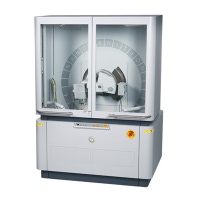Analytical technique of total scattering or pair distribution function analysis
Total scattering or pair distribution function analysis (PDF) is an analytical technique that can provide structural information from disordered materials by using the complete powder XRD pattern. The pair distribution function technique is also known as total scattering analysis.
Both the Bragg scattering and the underlying diffuse scattering are determined. From the Bragg peaks in an X-ray diffractogram, the long range order of the atoms can be deduced. The short range order, i.e. the local atomic structure, is present in the broad, less well-defined features in the diffractogram. This local structure is described quantitatively by the atomic pair distribution function.
Pair distribution function analysis is applied to the structural characterization of intrinsically disordered materials. Such materials can be amorphous, poorly crystalline, nano-crystalline or nano-structured. Typically, such samples are:
The PDF function itself is also used by the pharmaceutical industry as a fingerprint for amorphous materials. Other attractive areas of solid state chemistry research for PDF analysis include the study of energy-related materials: materials for solid oxide fuel cells (SOFC), magnetic materials, MOFs, zeolites and Li-battery materials.
From the measured X-ray diffractogram the so-called structure function is determined following initial basic data reduction steps. The radial atomic pair distribution function is then calculated by a Fourier transformation.
The pair distribution function describes the probability of finding two atoms separated by a certain distance in the material under investigation.
Software is then used to find the structural model that best fits the determined PDF function.

To obtain the desired spatial resolution for the local atomic structure, data acquisition for PDF analysis must be performed:
Due to these demanding requirements, the technique until recently almost exclusively relied on the high-quality X-ray beams that are available at synchrotron radiation sources.
In practice, it is often difficult and time-consuming to get access to such large-scale facilities. It is therefore highly desirable and sometimes even required to perform pre-screening on candidate samples in the research laboratory ahead of time.

Multipurpose X-ray diffractometers for your analytical needs
The Empyrean multi-purpose X-ray diffraction platform can be configured for total scattering experiments for PDF analysis.
The configuration uses:
Much attention has been paid to achieve a clean and featureless background, which is essential for obtaining meaningful results on highly disordered or fully amorphous materials.
Experimental data obtained with Malvern Panalytical systems allow for comparison with synchrotron results. The measured raw data can be processed and further analyzed with PDF analysis software packages that are available as freeware.

Empyrean Nano EditionVersatile X-ray scattering platform |

EmpyreanThe intelligent diffractometer |
|
|---|---|---|
| Technology | ||
| X-ray Diffraction (XRD) | ||